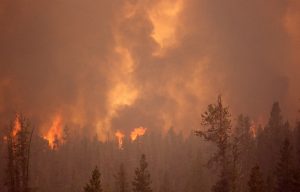Scientific research done in recent years has added to the evidence that a changing climate is making it harder to protect human health. These health impacts are a concern for the future, but are also evident right now, as rising global temperatures and disruption of short- and long-term weather continue to play a significant role in making the number of unhealthy ozone days higher than it would otherwise be.
According to the American Lung Association’s latest “State of the Air” report, the three years covered by the report (2019-2021) ranked among the seven hottest years on record globally. High ozone days and spikes in particle pollution related to heat, drought and wildfires are putting millions at risk and adding challenges to the work that states and cities are doing across the nation to clean up air pollution. They are also increasing the severity of pollution, resulting in a sharp rise in the number of days when the air quality poses an elevated risk of negative health effects. More than 30% of the nation’s population is exposed to high levels of ozone on enough days to earn the air they breathe a failing grade.
We just have to look at air quality in recent weeks to see firsthand the impact of wildfires alone, with smoke from the Canadian wildfires causing some of the worst air quality ever in New York and other U.S. cities, and also negatively impacting the air quality right here in the St. Louis region several days this summer.
While anyone who spends time outdoors where ozone pollution levels are high may be in danger, some people face a higher-than-average risk because of their underlying health and other characteristics. These populations include pregnant people and fetuses, children, anyone 65 and older, people with existing lung diseases such as asthma and COPD, and those who work or exercise outdoors.
To help keep these individuals and other St. Louisans informed about ozone pollution levels in the region and how those levels can affect their health, the Clean Air Partnership releases color-coded, daily air quality forecasts all summer long to let area residents know what the next day’s air quality is forecast to be and if they should alter their outdoor activities to minimize exposure to polluted air. This is especially important on orange or red ozone action days, which we’ve seen an excess of this season.
For more information and a host of additional tips to beat the summer heat to help clear the air and protect human health, visit cleanair-stlouis.com, like the Clean Air Partnership on Facebook or follow @gatewaycleanair on Twitter.

